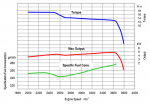OverkillTASF
Member
- 92
- 6
- 8
- Location
- Central Virginia
I know it has been asked and discussed a lot, but I'm curious... The guideline I mostly recently saw was something like "Make sure to periodically run at at least 80% load".

Given the above power curve... and some engines this may be even more pronounced... If someone wanted to run the engine for maximum fuel efficiency, they would run it at around 2600 RPM. Max power is 3600 RPM. Which yields:
Max fuel efficiency, 2600 RPM, 4.2HP output. 3.36HP load or more to prevent wet stacking.
Max power output, 3600 RPM, 4.9HP output. 3.92HP load or more to prevent wet stacking.
Now the "simple" question: Is wet stacking about the engine's max possible output, or just about the max possible output at a given RPM? Or is it about something else altogether, and the 80% guideline doesn't tell the whole store?
If I were designing a generator where noise and fuel efficiency were my primary concerns, and I could choose to run this engine at 2600 RPM, if I mated it with a proper generator or alternator head that could make use of its full 4.2HP at that RPM, I wonder if I'd have to run it at 3.92HP or 3.36HP load "periodically".

Given the above power curve... and some engines this may be even more pronounced... If someone wanted to run the engine for maximum fuel efficiency, they would run it at around 2600 RPM. Max power is 3600 RPM. Which yields:
Max fuel efficiency, 2600 RPM, 4.2HP output. 3.36HP load or more to prevent wet stacking.
Max power output, 3600 RPM, 4.9HP output. 3.92HP load or more to prevent wet stacking.
Now the "simple" question: Is wet stacking about the engine's max possible output, or just about the max possible output at a given RPM? Or is it about something else altogether, and the 80% guideline doesn't tell the whole store?
If I were designing a generator where noise and fuel efficiency were my primary concerns, and I could choose to run this engine at 2600 RPM, if I mated it with a proper generator or alternator head that could make use of its full 4.2HP at that RPM, I wonder if I'd have to run it at 3.92HP or 3.36HP load "periodically".



